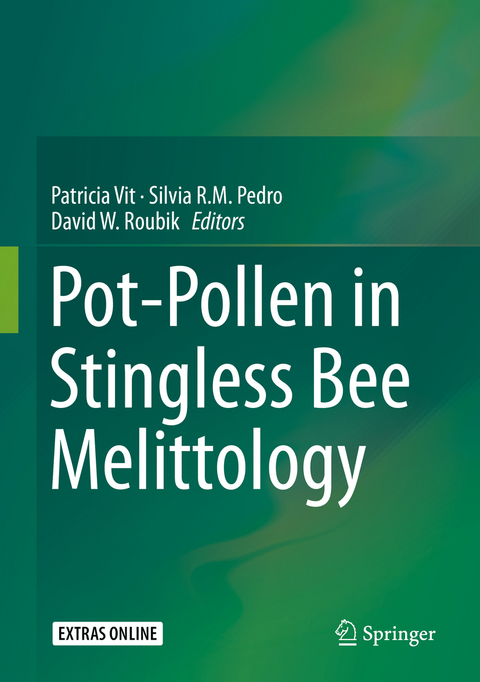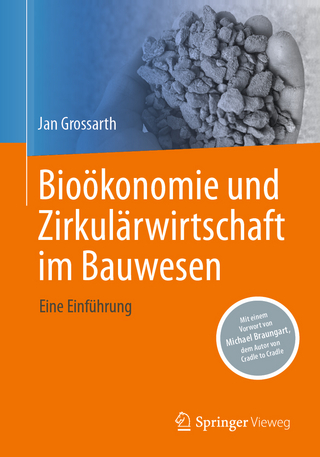
Pot-Pollen in Stingless Bee Melittology
Springer International Publishing (Verlag)
978-3-319-61838-8 (ISBN)
Professor Patricia Vit, MSc PhD Universidad de Los AndesFaculty of Pharmacy and BioanalysisFood Science DepartmentMérida, Venezuela The Sydney UniversityCancer Research GroupDiscipline of Biomedical ScienceSydney, Australia Dr. Silvia R.M. PedroUniversidade de São PauloSchool of Philosophy, Sciences and LiteratureBiology DepartmentBrasil Dr. David W. RoubikSmithsonian Tropical Research InstituteTerrestrial Biology DivisionEntomology DepartmentPanama
Forewords.- Introduction.- Acknowledgements.- SECTION 1 Pollen and the Evolution of Mutualism.- 1. Pot-Pollen as a Discipline. What Does it Include?.- 2. Are Stingless Bees a Broadly Polylectic Group? An Empirical Study of the Adjustments Required.- 3. Pollen collected by stingless bees: a contribution to understand Amazonian biodiversity.- 4. The Stingless Honey Bees (Apidae, Apinae: Meliponini) in Panama, and Ecology from Pollen.- 5. The value of plants for the Mayan stingless honey bee Melipona beecheii (Apidae: Meliponini): a pollen-based study in the Yucatán Peninsula, Mexico.- 6. Melittopalynological Studies of Stingless Bees from East Coast of Peninsular Malaysia.- 7. The Contribution of Palynological Surveys to Stingless Bee Conservation: a Case Study with Melipona subnitida.- 8. Pollen Storage by Melipona quadrifasciata anthidioides in a Protected Urban Atlantic Forest Area of Rio de Janeiro, Brazil.- 9. Angiosperm Resources for Stingless Bees (Apidae, Meliponini): A Pot-Pollen Melittopalynological Study in the Gulf of Mexico.- 10. Annual Foraging Patterns of the Maya Bee Melipona beecheii (Bennett, 1831) in Quintana Roo, Mexico.- 11. Crop Pollination by Stingless Bees.- 12. Stingless Bees as Potential Pollinators in Agroecosystems in Argentina: Inferences from Pot-Pollen Studies in Natural Environments.- SECTION 2 Biodiversity, Behavior and Microorganisms of the Stingless Bees (Meliponini).- 13. Stingless bees (Hymenoptera: Apoidea: Meliponini) from Gabon .- 14. Pushing 100 Species: Meliponines (Apidae: Meliponini) in a Parcel of Western Amazonian Forest at Yasuní Biosphere Reserve, Ecuador.- 15. Diversity of Stingless Bees in Ecuador, Pot-Pollen Standards and Meliponiculture Fostering a Living Museum for Meliponini of the World.- 16. Nesting Ecology of Stingless Bees in Africa .- 17. On the Trophic Niche of Bees in Cerrado Areas of Brazil and Yeasts in their Stored Pollen.- 18. A Review of the Artificial Diets Used as Pot-Pollen Substitutes .- 19. Yeast and Bacterial Composition in Pot-Pollen Recovered from Meliponini in Colombia: Prospects for a Promising Biological Resource .- SECTION 3 Stingless Bees in Culture and Traditions.- 20. Cultural, Psychological and Organoleptic Factors Related to the Use of Stingless Bees by Rural Residents of Northern Misiones, Argentina .- 21. The Maya Universe in a Pollen Pot Native Stingless Bees in Precolumbian Maya Art .- SECTION 4 Chemical Composition, Bioactivity and Biodiversity of Pot-Pollen.- 22. Nutritional Composition of Pot-Pollen from Four Species of Stingless Bees (Meliponini) in South East Asia .- 23. Characterization of Scaptotrigona mexicana Pot-Pollen from Veracruz, Mexico.- 24. Chemical Characterization and Bioactivity of Tetragonisca angustula Pot-Pollen from Mérida, Venezuela .- 25. Chemical, Microbiological and Palynological composition of the 'Samburá' Melipona scutellaris Pot-Pollen.- 26. Characterization of Pot-Pollen from Southern Venezuela .- 27. Bioactivity and Botanical Origin of Austroplebeia and Tetragonula Australian Pot-Pollen .- 28. Antibacterial Activity of Ethanolic Extracts of Pot-Pollen from Eight Meliponine Species from Venezuela.- 29. Metabolomics of Pot-Pollen from Three Species of Australian Stingless Bees (Meliponini).- SECTION 6 Marketing and Standards of Pot-Pollen.- 30. Rural-Urban Meliponiculture and Ecosystems in Neotropical areas. Scaptotrigona, a Resilient Stingless Bee?.- 31. Pot-Pollen "Samburá" Marketing in Brazil, and Suggested Legisation.- APPENDIX A Ethnic Names of Stingless Bees.- APPENDIX B Microorganisms Associated with Stingless Bees or Used to Test Antimicrobial Activity (AM).- APPENDIX C Taxonomic Index of Bees.- APPENDIX D List of Bee Taxa.- APPENDIX E Taxonomic Index of Plant Families.- APPENDIX F Microorganisms Associated to Stingless Bees or Used to Test Antimicrobial Activity.- INDEX.
"This book with contributions from scientists and experts studying stingless bees and meliponiculture gives an insight into pot-pollen which supports the stingless bees, and its many interesting biological characteristics that are only now beginning to be understood by scientists." (Bees for Development Journal, Issue 130, March, 2019)
“This book with contributions from scientists and experts studying stingless bees and meliponiculture gives an insight into pot-pollen which supports the stingless bees, and its many interesting biological characteristics that are only now beginning to be understood by scientists.” (Bees for Development Journal, Issue 130, March, 2019)
| Erscheinungsdatum | 06.11.2017 |
|---|---|
| Zusatzinfo | XXIV, 481 p. 132 illus., 87 illus. in color. |
| Verlagsort | Cham |
| Sprache | englisch |
| Maße | 178 x 254 mm |
| Gewicht | 1138 g |
| Themenwelt | Naturwissenschaften ► Biologie ► Ökologie / Naturschutz |
| Naturwissenschaften ► Biologie ► Zoologie | |
| Schlagworte | Animal Biochemistry • Animal ecology • Animal physiology • Animal Systematics/Taxonomy/Biogeography • Beekeeping • beekiping • biochemistry • Biomedical and Life Sciences • conservation biology • Entomology • Ethnopharmacology • Food & beverage technology • Food & beverage technology • Food chemistry • food science • honey • Life sciences: general issues • Meliponini • pot-pollen • Sociobiology • South America • stingless bee • Taxonomy & systematics • Taxonomy & systematics • Zoology & animal sciences • Zoology & animal sciences • Zoology: insects (entomology) & other invertebrate • Zoology: insects (entomology) & other invertebrate |
| ISBN-10 | 3-319-61838-5 / 3319618385 |
| ISBN-13 | 978-3-319-61838-8 / 9783319618388 |
| Zustand | Neuware |
| Haben Sie eine Frage zum Produkt? |
aus dem Bereich


